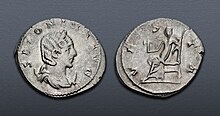| Cornelia Salonina | |||||||||
|---|---|---|---|---|---|---|---|---|---|
| Augusta | |||||||||
 Marble bust of Cornelia Salonina Marble bust of Cornelia Salonina | |||||||||
| Empress of the Roman Empire | |||||||||
| Tenure | 253 – 268 | ||||||||
| Born | Possibly Bithynia | ||||||||
| Died | 268 (disputed) Mediolanum, Italia (disputed) | ||||||||
| Spouse | Gallienus | ||||||||
| Issue | Valerianus Saloninus Marinianus | ||||||||
| |||||||||
| Dynasty | Valerian | ||||||||
Publia Licinia Julia Cornelia Salonina (died 268, Mediolanum) was an Augusta of the Roman Empire, married to Roman Emperor Gallienus and mother of Valerian II, Saloninus, and Marinianus.
Life


Salonina's origin is unknown. One modern theory is that she was born of Greek origin in Bithynia, then part of the province of Bithynia et Pontus, Asia Minor. However, there exists some scepticism on that. There has been speculation that she was related to a senator named Publius Cornelius Saecularis of Salona. She may also have been related to her father-in-law's second wife Cornelia Gallonia.
She married Gallienus about ten years before his accession to the throne. When her husband became joint-emperor with his father Valerian in 253, Salonina was named Augusta.
Salonina was the mother of three princes, Valerian II, Saloninus and Marinianus. Her fate after Gallienus was murdered during the siege of Mediolanum in 268 is unknown. One theory is that her life was spared; another is that she was executed together with other members of her family, at the orders of the Senate of Rome.
Her name is reported on coins with Latin legend as Cornelia Salonina; however, from the Greek coinage come the names Iulia Cornelia Salonina, Publia Licinia Cornelia Salonina, and Salonina Chrysogona (attribute that means "begotten of gold"). The names "Publia Licinia" were probably added to her name to mirror her husband whose two first names were "Publius Licinius".
References
- Bray (1997), pp. 30, 347. Supporters of Greek Bithynian origin include Andreas Alföldi in "Die Vorherrschaft der Pannonier im Römerreiche und die Reaktion des Hellenentums unter Gallienus", Studien zur Geschichte der Weltkrise des 3, Jahrhunderts nach Christus. M.78 Taf. Darmstadt, 1967; and R. Munsterburg in Numismatische Zeitschrift, vol. LVIII (1925), p. 41
- Lissner, Ivar (1958). The Caesars: might and madness. Putnam. p. 291. OCLC 403811.
Gallienus' wife was a remarkably sensitive and cultured Greek woman named Cornelia Salonina who came from Bithynia
- Bengtson, Hermann – Bloedow, Edmund Frederick (1988). History of Greece: from the beginnings to the Byzantine era. University of Ottawa Press. p. 344. ISBN 0-7766-0210-1.
The Empress Salonina, a Greek from Bithynia, took an avid part in the philhellenic efforts of the emperor.
{{cite book}}: CS1 maint: multiple names: authors list (link) - Bray (1997), p. 30, who cites Jean Gagé, Programme d' italicité et nostalgies d'hellénisme autour de Gallien et Salonine, Aufstieg und niedergang der Römischen Welt, vol. 5, New York, 1975, ISBN 3-11-004971-6, p. 839
- Bulletin archéologique du Comité des travaux historiques et scientifiques. Impr. nationale. 1970. p. 189.
- Barbieri, Guido (1951). L'albo senatorio da Settimio Severo a Carino. 193-285. Studi pubblicati dall'Istituto italiano per la storia antica. Vol. 6. A. Signorelli. p. 271.
- Jefferson Bray, John (1997). Gallienus: A Study in Reformist and Sexual Politics. Wakefield Press. p. 30. ISBN 9781862543379.
- Wilkes, J. J. (1969). Dalmatia. History of the provinces of the Roman Empire. Harvard University Press. p. 334. ISBN 9780674189508.
- Alföldy, Géza (1968). Epigraphische Studien: Sammelband. Beihefte der Bonner Jahrbücher. Vol. 5. Rheinland-Verlag. pp. 127, 130, 142.
- Syvänne, Ilkka (2019). The Reign of Emperor Gallienus: The Apogee of Roman Cavalry. Pen and Sword. ISBN 9781526745224.
- Bray (1997), pp. 50-51
- Bray (1997), p. 308
- Alaric Watson, Aurelian and the Third Century, (Oxford: Routledge, 1999) ISBN 0-415-30187-4, p. 41
- Kajava, Mika (1995). Roman Female Praenomina: Studies in the Nomenclature of Roman Women. Acta Instituti Romani Finlandiae. Vol. 14. Institutum Romanum Finlandiae. p. 182. ISBN 9789519690216.
Bibliography
- Bray, John. Gallienus : A Study in Reformist and Sexual Politics, Wakefield Press, Kent Town, 1997, ISBN 1-86254-337-2
- "Salonina", Dictionary of Greek and Roman Antiquities, edited William Smith (1870).
- Partial Salonina coinage
- "Dictionary of Roman Coins", by Seth William Stevenson (1889).
Further reading
- (in French) Minaud, Gérard, Les vies de 12 femmes d’empereur romain - Devoirs, Intrigues & Voluptés , Paris, L’Harmattan, 2012, ch. 11, La vie de Cornélia Salonina, femme de Gallien, p. 263-284.
External links
| Royal titles | ||
|---|---|---|
| Preceded byCornelia Supera | Empress of Rome 253–268 |
Succeeded byUlpia Severa |
| Preceded byHerennia Etruscilla | Empress-Mother of Rome 260 |
Succeeded byEutropia |